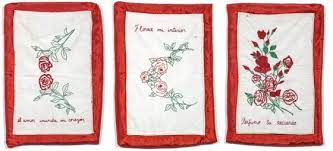(San Ignacio, Paraguay, 1962-Buenos Aires, Argentina 1996)
Born in Paraguay, he moved as a child to the neighboring city of Formosa, in Argentina. In the work there are elements related to domesticity that bring together issues shared between Paraguay and the Argentine periphery: the history of women, the laxity of their naps and the survival of kitsch. Household goods and textiles are central to his work. Practically in all the texts in which reference is made to Centurión’s blankets, the word “coat” is used, which he himself mentions several times. These blankets, widely used in the region, are, indeed, the shelter of many beds. His work permanently evokes the spirit of the popular culture of his native country and the family context where he grew up, an environment where he learned to sew and embroider. Centurión was part of the group that, around the Rojas Cultural Center, forged an aesthetic that strongly defined the generation of artists of the 90s. The affective dimension was a central pattern of his work and is evident in the series “Flores del mal de amor ”. Made in the last year of his life, this highlights the qualities of his autobiographical narrative. Affected by AIDS, in each piece Centurión embroidered phrases that talk about love, desire and illness.


 Centurión Feliciano
Centurión Feliciano